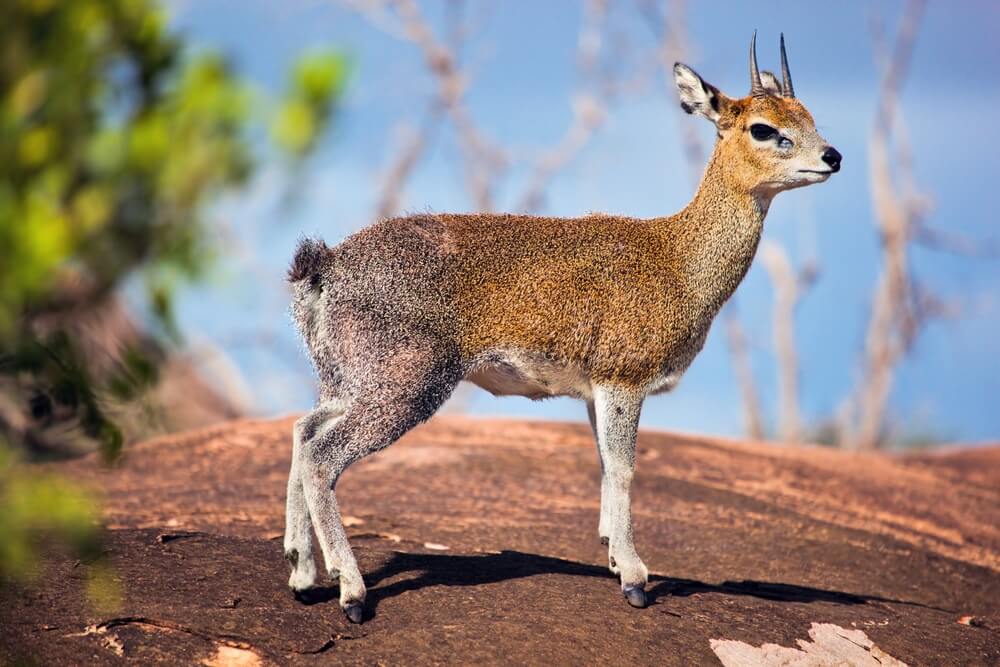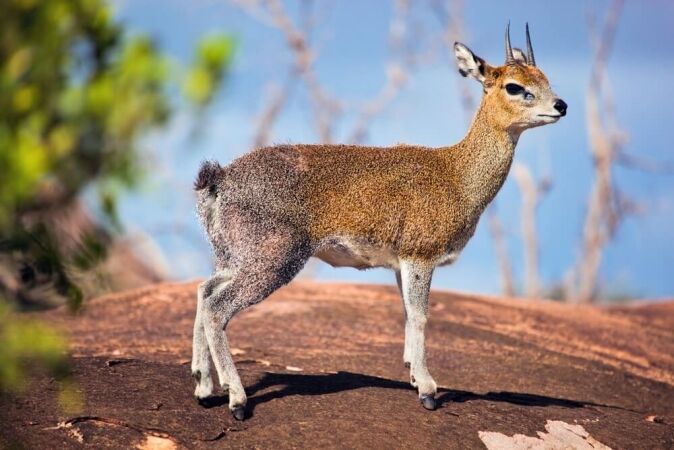

Klipspringers (Oreotragus oreotragus) inhabit eastern and southern Africa. Their range extends from northeastern Sudan, Eritrea, northern Somalia, and Ethiopia in the east, to South Africa in the south, and they also inhabit the coastal regions of Angola and Namibia. Their habitat includes rocky terrain, particularly areas with koppies (hilly outcrops) and sparse vegetation, but they can also thrive in river beds and even in mountains reaching up to 13,000 feet.
The name klipspringer means ‘rock jumper’ in South Africa’s local Afrikaans language. The rock jumper analogy refers to its ability to move freely around its chosen rocky territory by jumping between rocks with little effort. Unlike other antelopes, klipspringers can stand on the tips of their hooves. With four hooves, each the size of a dime, they can jump from a standing position onto another rocky area that is only three inches big!
This sure-footed rock climber is a herbivore, and it finds all its food and water requirements from the area it inhabits. They typically stay in a 20-120-acre territory. Its diet includes flowers, tender green shoots and fruits, shrubs and herbs. It hardly feeds on grass and is not dependent on water, as the foods it consumes has a high water content.
These pigmy antelopes are monogamous and pair up for life. They are territorial, with male and female klipspringers defending their territory against invaders. After a gestation period of six months, a single lamb is born in spring or summer. The young mature at about one year of age and will leave home, find a mate and establish their own territory.
This nimble-footed pigmy antelope has numerous predators including leopards, jackals and spotted hyenas. The klipspringer’s lambs are vulnerable to eagles and baboons while still small.
They are very alert to predators and react by fleeing to higher ground and can outrun most predators. They tend to give a sharp screeching whistle when alarmed. This, unfortunately, reveals their hiding spot.
They can reach higher ground quickly and with relative ease, but tend to stop and look backwards to see if they are still being chased! This gives the predator time to pounce if it is close enough, or in the case of a hunter, time to get the shot in on his hunting safari and bag a pinnacle member of the Tiny 10!
Name:
Oreotragus Oreotragus
Weight:
18-40 pounds
Shoulder Height:
17-23.5 inches
Range:
Eastern and Southern Africa
Gestation Period:
6 months
Life span:
15 years
Not Enough Information
When on a game hunting safari for klipspringers, look for a small, sturdy, stocky antelope with well-developed back legs. It has a coarse coat, ranging in color with shades of gray, yellow, red or brown. The shades of its coat allow it to camouflage well and ward off possible predators. Its underbelly, chin and lips are a whitish color. Typically, males have horns, but there have been cases reported of females in East Africa with horns. Klipspringers’ horns are short and spiky, measuring approximately 3-3.5 inches.
There are some beautiful spots to enjoy a hunting safari in South Africa, specifically targeting this member of the Tiny 10! Klipspringer hunting in South Africa is completed by stalk and spot. Klipspringers are rarely spotted, so be prepared to wait it out. They are most active in the early morning or late afternoon and early evenings.
Hunting klipspringers in Africa can be an immense challenge for hunters as they can be difficult to spot. Their terrain is challenging to navigate, allowing many hiding spots, plus hunters need to be relatively fit for this hunting adventure. Good eyewear to protect against the sun, and a pair of binoculars are recommended, as you may spend large amounts of time trying to spot these nimble-footed antelopes.
When klipspringer hunting in Africa, any smaller caliber scoped rifles, such as the .22 to .243 will get the job done. Bullet tips should not be more than 45 to 55 grains. Ensure you use a solid or monolithic tip. Don't use any larger caliber, as damage to your trophy klipspringer could be catastrophic.
Search from our range of Hunts across various popular destinations in Africa.
Find A Hunt